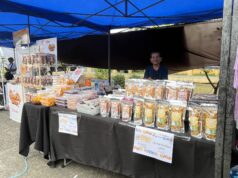But they are still sources in generating generations as their sperms live on.
In five dewar flasks (liquefied gas container) at the National Freshwater Fishery Technology Center (NFFTC) on the compound of the Central Luzon State University (CLSU) here, their milts are cryopreserved. They can be retrieved anytime for crossbreeding to produce new tilapia strains.
Considered as best performing Nile tilapia, they were gathered from Egypt, Kenya, Senegal, Ghana, Israel, Singapore, Taiwan and Thailand.They were used for 64 crossing combinations from which excellent performing tilapia strains were selected, developed and are now commercially produced in huge volumes cycle after production cycle.
“They (the sperms) are placed in plastic straws and are preserved in a temperature of minus 196 degree Celsius,” Ma. Jodocel Casayuran- Danting, officer-in-charge of the NFFTC, said.
Danting was a member of the team that started the cryopreservation project in 1993.
“These sperms are also useful in checking the defects of foundation stocks of fish seeds (eggs, larvae, and fries) which produce the fingerlings for commercial production,” Danting added.
Tilapia in PH
The tilapia is endemic to Africa with various species and sub-species. The most famous of them now being cultured in many countries is the Nile tilapia (Oreochromis niloticus).
History says the aquaculture of Nile tilapia dates back to Ancient Egypt and was one of the three main types of fish caught in Biblical times from the Sea of Galilee. Called Amnoon in Hebrew (mother fish), it is called Musht (comb, as resembled by its comb-like backfi n)) in Arabic or its other Biblical allusion “St. Peter’s fish”.
In 1950, the Mossambique tilapia strain from Thailand was introduced in the country but was not widely accepted due to its dark color and small size.
It was in the early 1970s that the widely liked Nile tilapia boosted the commercial production of this freshwater fish in the country.
For fishery scientists, tilapia is the Cinderella fish that suits up the criteria for its popularization.
They possess characteristics suitable for relative easy culture, its prolific nature can help solve the problem of fry shortage, is efficient converter of water foodstuff s, has short food chain due to its being a plankton feeder, can adapt easily to adverse conditions, resistant to diseases, has good eating quality, and is relatively cheaper in the market.
Over time, however, due to lack of systematic efforts to improve its genetics, its quality deteriorated and somewhat lost its appeals to the growers and consumers.
To improved its strain, the then International Center for Living Aquatic Resources Management (ICLARM), which was formed in the Philippines in 1987, established partnership with other agencies including the then National Freshwater Fisheries Technology Center (now NFFTC) of the Bureau of Fisheries and Aquatic Resources (BFAR) and, using the tilapia strain gathered from other countries, started developing the Genetically Improved Farm Tilapia (GIFT).
The resulting developed strain heightened popular interest in tilapia farming in the Philippines and in 11 other Asian countries in which it was distributed.
Eventually, the forebears of this GIFT strain were subjected to cryopreservation.
The gene bank where they are preserved is described by fish scientists as “one of the most valuable gene banks” in the world and a long-term resource for building new generations of Nile tilapia strains.
Derived strains
From the GIFT, NFFTC produced the GET-EXCEL strain (GET is genetically enhanced tilapia and EXCEL is short for excellent). This strain is now the national basis of Philippine tilapia breeding program.
“We have also come up with the ‘I-Excel” or improved GET-EXCEL strain. Breeders of this strain are now being distributed in technology |outreach stations, central hatcheries, and accredited breeding stations, Danting said.
Due to the improved strains of tilapia, commercial production in the country increased dramatically. From 81,954 metric tons (mt) in 1995 it shot up to 163,003 mt in 2005. In 2015, total production in volume was 311,690 mt., which was second to milkfish’s 392,740 mt volume.
Globally, according to then Agriculture Secretary Proceso Alcala, the Philippines was ranked fourth in 2014 in terms of production. China, Indonesia and Egypt topped the ranking in that order. Brazil came very close in 5th spot.
“But we can increase some more our tilapia production if we can expand our growing areas. One big potential is the production in brackish water (mixture of saltwater and freshwater) ponds for tilapia grow-out,” Danting said. “They are along our vast coastlines.”
She said, though, that one of their big concerns is the replication of their cryopreserved sperm of the ancestortilapia here.
“We have to replicate it so that in case of disaster that may damage our cryo-preserved sperms, we still have this resource stored somewhere,” Danting said.
Out there, she added, there are potential partners for this project and “we are waiting for them”.




